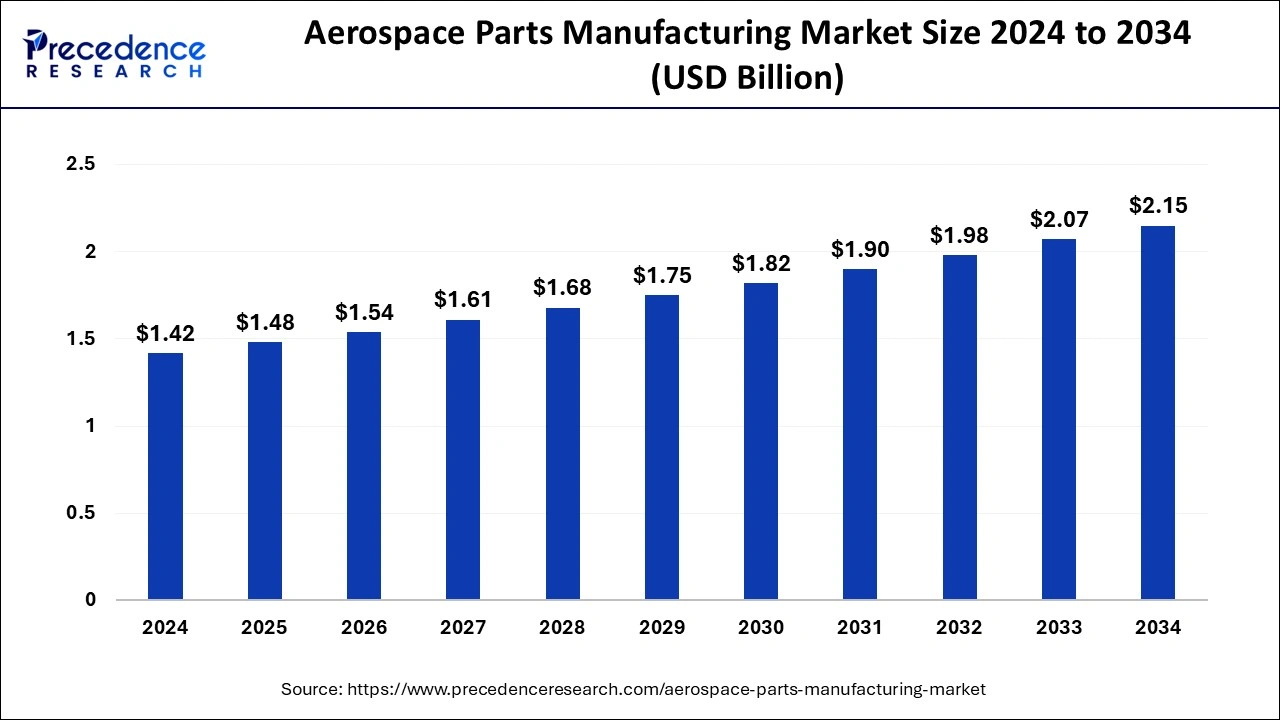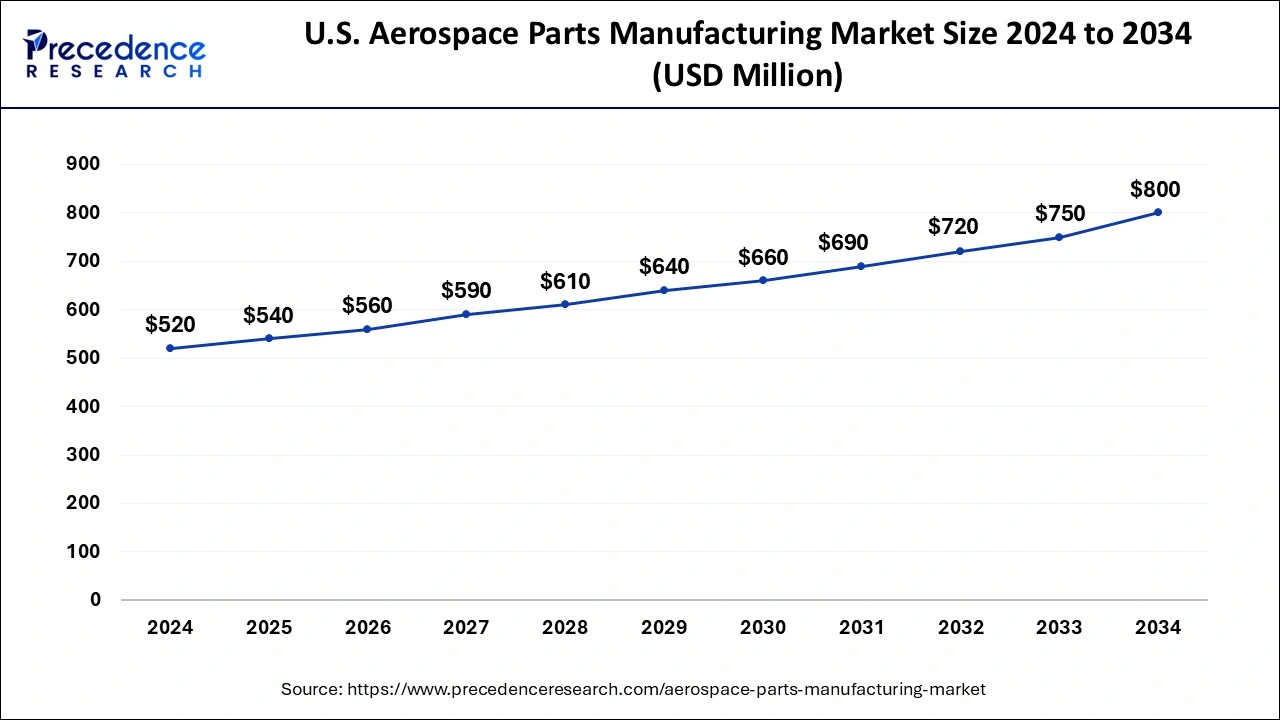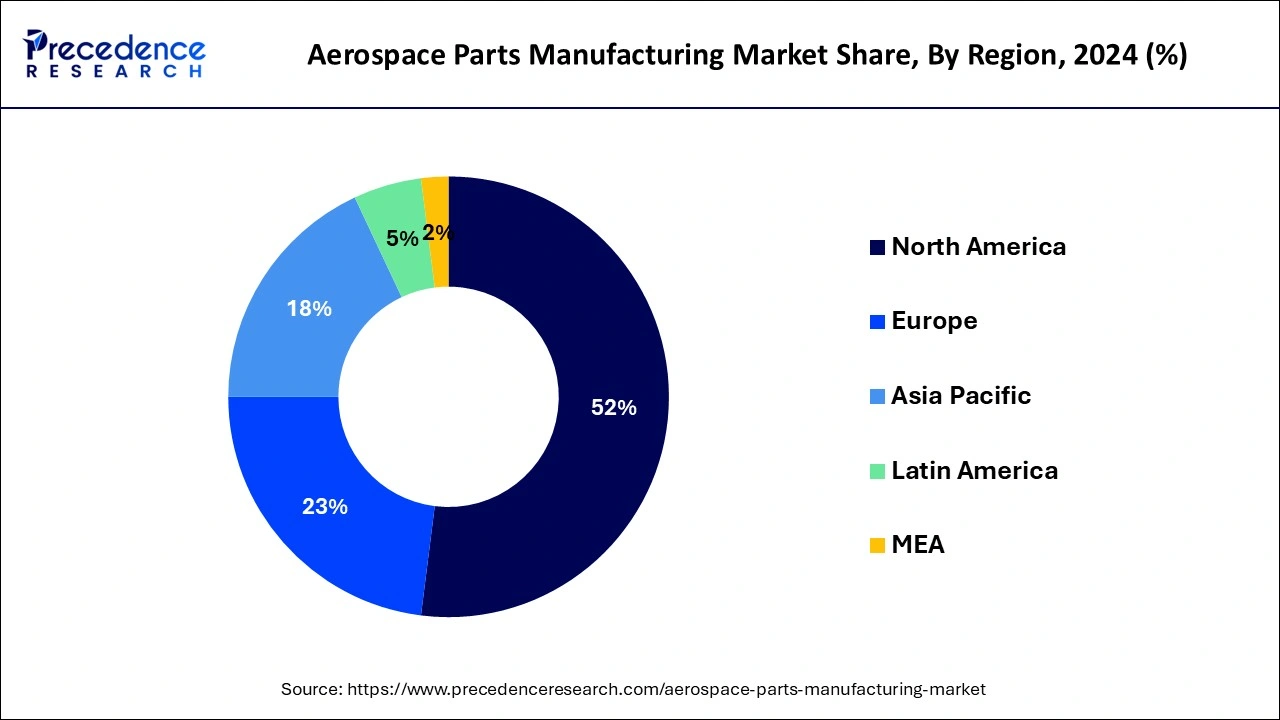July 2024
The global aerospace parts manufacturing market size is calculated at USD 1.48 billion in 2025 and is forecasted to reach around USD 2.15 billion by 2034, accelerating at a CAGR of 4.24% from 2025 to 2034. The North America aerospace parts manufacturing market size surpassed USD 740 million in 2024 and is expanding at a CAGR of 4.32% during the forecast period. The market sizing and forecasts are revenue-based (USD Million/Billion), with 2024 as the base year.
The global aerospace parts manufacturing market size was estimated at USD 1.42 billion in 2024 and is predicted to increase from USD 1.48 billion in 2025 to approximately USD 2.15 billion by 2034, expanding at a CAGR of 4.24% from 2025 to 2034.

The U.S. aerospace parts manufacturing market size was valued at USD 520 million in 2024 and is projected to reach USD 800 million by 2034 with a CAGR of 4.40% from 2025 to 2034.

North America led the market with the biggest market share of 52% in 2024 due to a robust aviation industry, comprising leading companies like Boeing and Lockheed Martin. The region benefits from substantial defense spending, driving demand for military aircraft components. Additionally, advanced technology adoption and a strong focus on research and development contribute to North America's dominance. The presence of key aerospace manufacturers, strategic collaborations, and a well-established supply chain further solidify the region's position as a major contributor to the global aerospace parts manufacturing market.

Asia-Pacific is poised for rapid growth in the aerospace parts manufacturing market due to the expanding aviation industry, rising air travel demand, and increasing defense spending. Countries like China and India are investing significantly in aerospace infrastructure and technology. As global aircraft production shifts towards Asia-Pacific, the region becomes a key hub for manufacturing components. Moreover, the growing interest in space exploration and satellite launches further contributes to the region's prominence in the aerospace sector, fostering economic development and technological advancements.
Meanwhile, Europe is experiencing notable growth in the aerospace parts manufacturing market due to several factors. The region boasts established aerospace companies, leading in technological innovation and production efficiency. Increasing demand for commercial aircraft, military modernization, and a growing emphasis on sustainable aviation contribute to this growth. Moreover, collaborations and partnerships between European manufacturers and global aerospace players further enhance the competitiveness of the European aerospace parts manufacturing sector, solidifying its position as a key player in the global aerospace industry.
The aerospace parts manufacturing market involves the production of components and equipment for aircraft and spacecraft. This complex process encompasses designing, fabricating, and assembling various parts that make up the structure and systems of airplanes, helicopters, and spacecraft. From engine components to navigation systems, aerospace manufacturers play a crucial role in ensuring the safety and functionality of aerospace vehicles. These manufacturers employ advanced technologies and materials to meet stringent industry standards. Precision and quality are paramount in aerospace parts manufacturing, as even the smallest component must adhere to strict specifications to guarantee the reliability and efficiency of the overall aerospace system. The industry is characterized by innovation, with continuous advancements in materials and manufacturing techniques driving progress in aviation and space exploration.
| Report Coverage | Details |
| Market Size in 2025 | USD 1.48 Billion |
| Market Size by 2034 | USD 2.15 Billion |
| Growth Rate from 2025 to 2034 | CAGR of 4.24% |
| Base Year | 2024 |
| Segments Covered | By Product and By End-use |
| Regions Covered | North America, Europe, Asia-Pacific, Latin America, and Middle East & Africa |
Noise-induced hearing loss (NIHL)
The surge in global air travel significantly boosts the demand for aerospace parts manufacturing. As more people choose air transportation, airlines around the world seek to expand their fleets to meet the rising passenger numbers. This increased demand for new aircraft creates a domino effect on the aerospace parts market, as manufacturers must produce a wide range of components to build and maintain these airplanes. Airlines require various parts, from engines to avionics and structural components, to ensure the safety and efficiency of their fleets. This heightened demand not only benefits established aerospace companies but also encourages innovation and competition within the industry. The growth in global air travel acts as a catalyst, driving the production of advanced, reliable, and fuel-efficient aerospace parts to meet the evolving needs of the aviation sector and contribute to the overall expansion of the aerospace parts manufacturing market.
Cyclical nature of the industry
The cyclical nature of the aerospace industry introduces challenges for the aerospace parts manufacturing market, influencing market demand. This cyclicality is closely linked to economic conditions and impacts the overall health of the aviation sector. During economic downturns or crises, airlines may experience financial constraints, leading to deferred or canceled orders for new aircraft and associated components. The result is a fluctuating demand for aerospace parts, affecting manufacturers' production levels and revenue streams. The industry's reliance on a stable economy underscores the vulnerability of aerospace parts manufacturing to economic downturns. Consequently, companies in this market need to implement robust strategies for navigating through economic cycles, including diversification, cost management, and flexibility in production capacity to withstand the impact of fluctuations in demand and ensure long-term sustainability.
Rising demand for lightweight materials
The surging demand for lightweight materials in the aerospace industry presents significant opportunities for aerospace parts manufacturing. As airlines and aircraft manufacturers increasingly prioritize fuel efficiency and environmental sustainability, there is a growing need for advanced lightweight materials. This trend creates a distinct market opportunity for aerospace parts manufacturers to innovate and develop cutting-edge components using materials such as advanced composites and alloys. These lightweight materials not only contribute to fuel savings but also enhance overall aircraft performance, leading to increased demand for components that meet the industry's evolving standards.
Manufacturers can capitalize on this opportunity by investing in research and development to create materials that are not only lightweight but also durable and cost-effective. Companies that can successfully integrate these materials into their aerospace components stand to gain a competitive edge in the aerospace parts manufacturing market, as airlines seek to modernize their fleets with more fuel-efficient and environmentally friendly aircraft. As the industry continues to prioritize weight reduction, aerospace parts manufacturers have the chance to play a pivotal role in shaping the future of aviation through the production of advanced lightweight components.
The aircraft manufacturing segment held the highest market share based on the product in 2024. The aircraft manufacturing segment in the aerospace parts manufacturing market involves the production of entire aircraft, encompassing airframes, wings, engines, and other integral components. A significant trend in this segment is the increasing adoption of advanced materials like composites for constructing aircraft structures, aiming to reduce weight and enhance fuel efficiency. As the aviation industry emphasizes modernization and sustainability, aircraft manufacturers seek innovative solutions within this segment, driving the evolution of materials and manufacturing processes for more efficient and environmentally friendly air travel.
The avionics segment is anticipated to witness rapid growth at a significant CAGR during the projected period. Avionics is a critical segment in aerospace parts manufacturing that encompasses electronic systems used in aircraft for communication, navigation, monitoring, and control. Avionics components include instruments, displays, radar systems, and communication equipment. A significant trend in the aerospace industry is the rapid advancement of avionics technology. Manufacturers are developing more sophisticated and integrated avionics systems, incorporating features like digital communication, automation, and enhanced navigation capabilities. This trend responds to the industry's demand for safer, more efficient, and technologically advanced aircraft, driving innovation in avionics products.
According to the end-use, the commercial segment held the largest share in the aerospace parts manufacturing market in 2024. The commercial segment in aerospace parts manufacturing refers to the production of components specifically designed for commercial aircraft. This includes manufacturing parts for passenger planes, cargo planes, and other aircraft used in commercial air travel. In recent trends, the commercial aerospace segment has witnessed a surge in demand for lightweight materials, fuel-efficient components, and advanced avionics. Airlines and aircraft manufacturers are increasingly focusing on upgrading and modernizing their fleets, driving the need for innovative and technologically advanced aerospace parts tailored to commercial aviation requirements.
The business segment is anticipated to witness rapid growth over the projected period. The business segment in aerospace parts manufacturing refers to the various end-use categories for the components produced. This includes commercial aviation, defense, and space exploration. In recent trends, the commercial aviation segment has seen substantial growth due to increased air travel demand. The defense sector remains a crucial end-use, driven by military modernization initiatives globally. Additionally, the rising interest in space exploration has opened new opportunities, with companies contributing components for satellite launches and other space-related applications, diversifying the aerospace parts manufacturing market.
By Product
By End-use
By Geography
For inquiries regarding discounts, bulk purchases, or customization requests, please contact us at sales@precedenceresearch.com
No cookie-cutter, only authentic analysis – take the 1st step to become a Precedence Research client
July 2024
November 2024
February 2025
November 2023